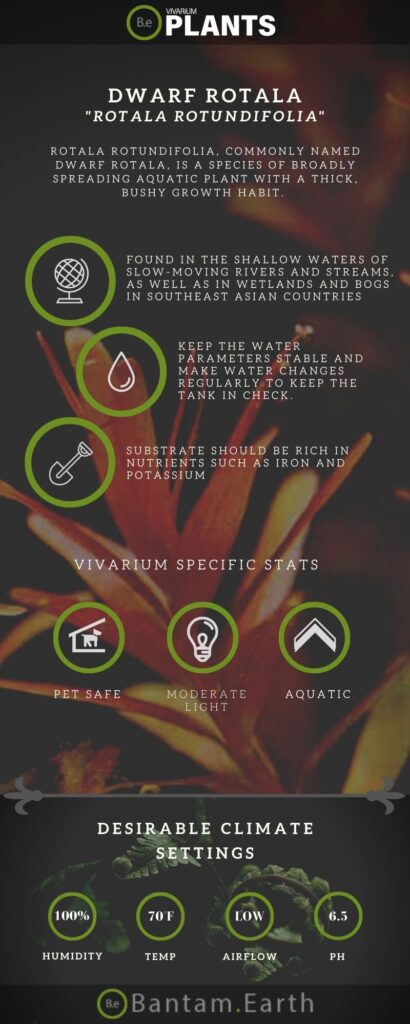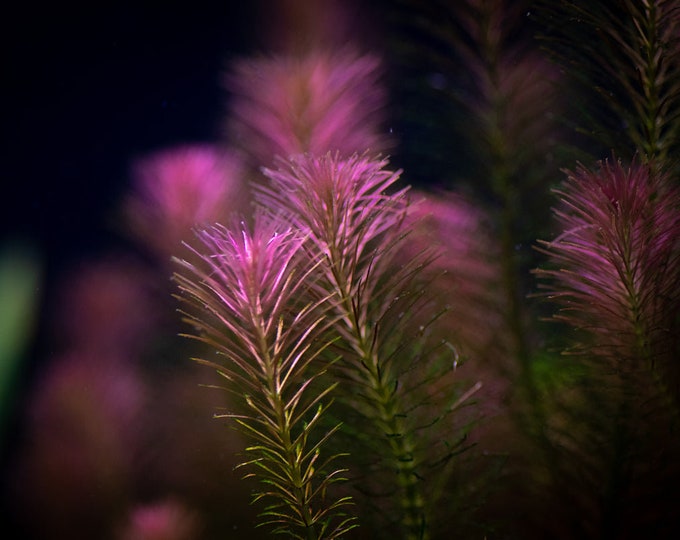Welcome to our article about Rotala rotundifolia, better known as Dwarf Rotala, a popular aquarium and terrarium plant.
This vibrant aquatic plant has been known to bring a splash of color and life to any tank.
From its bright, luscious green leaves to its unique growth habit, Dwarf Rotala is sure to bring a touch of vibrancy to your terrarium.
In this article, we’ll explore the features and care requirements of this plant so you can choose if it’s best for your tank.
Dive in to learn everything you need to know about bringing Dwarf Rotala into your terrarium!
Table Of Contents:
ToggleWhat is Dwarf Rotala?
Rotala rotundifolia, commonly named Dwarf Rotala, is a species of broadly spreading aquatic plant with a thick, bushy growth habit.
It’s a relatively undemanding plant, growing in quite a broad range of light and water conditions.
This makes Dwarf Rotala ideal to keep in aquariums, ripariums, and paludariums alike.


Dwarf Rotala Facts
The unique design and growth pattern of this plant makes it an ideal choice for any aquascapes.
This plant is native to southern Thailand and Vietnam, where it inhabits humid wetlands and slow-moving rivers and streams.
Dwarf Rotala has a thick, upright stem and densely packed, rounded leaves that form a cushion-like formation in and around the substrate.
Description
Dwarf Rotala is characterized by its thick, upright stem, which can reach lengths of 8-10 inches.
It’s got medium to dark green leaves that are tightly packed together and have a rounded shape.
They form in such a way that they usually look like a cushion, creating a dense, full coverage of the substrate and vegetation below.
Habitat
Dwarf Rotala is a naturally occurring plant, found in the shallow waters of slow-moving rivers and streams, as well as in wetlands and bogs in Southeast Asian countries, such as Thailand and Vietnam.
It’s found in areas with a high humidity level, where there is shallow water and plenty of sunlight.
pH Preference
Dwarf Rotala is adapted to growing in waters that range from being more acidic to more alkaline.
The acceptable pH range for the plant is from 5.5 to 7.5.
A balance between 5.8 to 6.8 is ideal for keeping this plant.
Vivarium Type
Rotala rotundifolia is quite an easy-going species.
With that in mind, it will not be too complicated when it comes to choosing the type of enclosure it is grown in.
It is best to try and replicate the plant’s natural habitat as much as possible.
Doing so will make it easier to provide this foliage plant with its basic needs.
The proper setup and theme of the enclosure will make a big difference to the overall look and health of the plant.
Be sure to choose setups that are moist and high in humidity.
Here are recommended vivariums it will do well in:
-
- Paludariums – Half aquatic/ half terrain-based enclosure.
-
- Terrariums – Fully terrain-based enclosures with little to no aquatic features.
-
- Ripariums – Mostly aquatic-based enclosures with some terrain features present.
-
- Aquarium– Fully aquatic-based enclosure with little to no dry terrain.
Vivarium Placement
In the aquatic portion of a vivarium, Dwarf Rotala is best used as a background plant.
Its fast-growing nature and large size make it a great option for adding height and volume to an aquatic setup.
Due to its heavy growth, this plant can also be used to hide any equipment or filter tubes within an aquarium.
Substrate
A nutrient-rich aquatic soil substrate is an ideal environment for Dwarf Rotala.
As it’s an aquatic plant, it will require a place to attach its roots to something strong and secure.
Gravel, sand, and clay substrates are all suitable, however, the soil is preferred.
The substrate should be rich in nutrients such as iron and potassium, as they are vital for the health and longevity of this plant.
Lighting
Dwarf Rotala is an easy-to-care-for plant that needs medium to high light levels.
It’s important to place it away from direct sunlight in order to prevent the plant from receiving too much intense light.
It does well with LED or fluorescent aquarium lighting that’s around 8-12 hours a day.
Buy Dwarf Rotala
When it comes to buying Rotala rotundifolia, there are a few things to keep in mind.
Making sure the plant is healthy when purchased is essential for its success in a vivarium or pond.
Vegetation that is already in poor conditions will have a very hard time adjusting to new environments.
Click the image below to find out more about the current price and other relative info about this plant.
Dwarf Rotala Care and Propagation
Dwarf Rotala is a great option for beginner aquarists, as it’s an easy-to-care-for plant.
Like many aquatic plants, propagation happens naturally by releasing new growths from the mother plant.
Keeping the leaves of Dwarf Rotala clean and free of algae will help the plant to look its best.
How to Grow
The best way to propagate Dwarf Rotala is to take cuttings of one or two stems from the mother plant and place them into a separate tank with the same water parameters.
Make sure to cut just below the node and that there are two or more leaf nodes present on the cutting.
Plant the cutting in the substrate and ensure the root system is generally covered, although it doesn’t need to be completely buried.
Water Requirements
Dwarf Rotala prefers a moderate level of water movement.
However, it should not be placed in an area of strong or turbulent current.
Keep the water parameters stable and make water changes regularly to keep the tank in check.
When growing the plant emerged, it is recommended to avoid water droplet formation on the leaves.
This is key to preventing any fungal growth and infections that can occur.
Plants Similar to Dwarf Rotala
Adding diversity to an enclosure is key to an aesthetically pleasing setup.
Try mixing up the look of your vivarium with different flora that can easily co-exist in the same types of environment.
Furthermore, if for some reason you find the Dwarf Rotala hard to acquire or would like to consider something similar to this aquarium plant…
Here are other aquatic plants you might find will do well with or in place of Rotala rotundifolia:
Conclusion
We hope this article has taught you everything you need to know about Dwarf Rotala!
This vibrant aquatic plant undoubtedly offers a beautiful way to add a touch of life to your vivarium.
When properly cared for, Dwarf Rotala can easily be a centerpiece of your tank for many years to come.
Whether you’re just starting with aquariums and paludariums, or you’re a seasoned expert, this plant is an excellent addition that everyone can appreciate.
Get out there and start on your aquatic adventure with Dwarf Rotala!
Frequently Asked Questions
No, Rotala rotundifolia does not need CO2 to thrive in an aquarium environment. However, carbon dioxide (CO2) helps to increase the growth rate as well as the overall health and color of the plant. Additionally, adding CO2 to the aquarium helps to balance out the pH level, which can be beneficial to aquatic life.
Yes, Rotala rotundifolia needs a nutrient–rich substrate to propagate and remain healthy.
Yes, Rotala rotundifolia can turn red when exposed to high lighting levels combined with either the absence of or low levels of CO2.
Yes, you can plant Rotala in gravel. The gravel should be large enough to support the plant‘s roots, and care should be taken to ensure the gravel isn‘t too sharp to avoid damaging the plant‘s stems and leaves. Additionally, proper fertilization, light, and CO2 levels should still be maintained to ensure the Rotala grows.
Yes, Rotala plants can grow in low light conditions. They require bright light for optimal growth, but if lighting is kept at a low to medium intensity, Rotala will still be able to survive. Good water quality and CO2 supplementation can help aid growth in low light environments.
To make Rotala bushy, prune the stems back to near the water line and provide good water circulation. Ensure that the plant is well–lit, use fertilizer that is high in nitrogen, and adjust the CO2 levels as needed. To encourage bushier growth, cut the top of each stem, or selectively trim the stems to shape it. Additionally, trim off any dead or decaying leaves and make sure to trim any long, stringy branches. Finally, make sure to perform regular water changes to keep the tank clean and healthy.
Rotala rotundifolia typically grows to a height of 8–10 inches.
Rotala Rotundifolia typically grows 4–5 inches per year.




